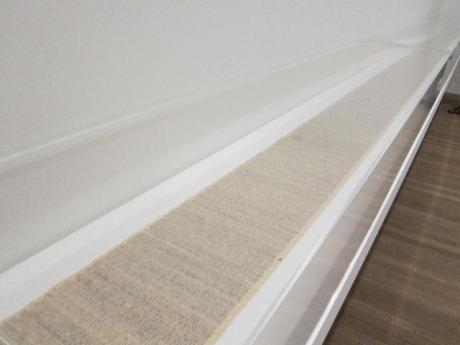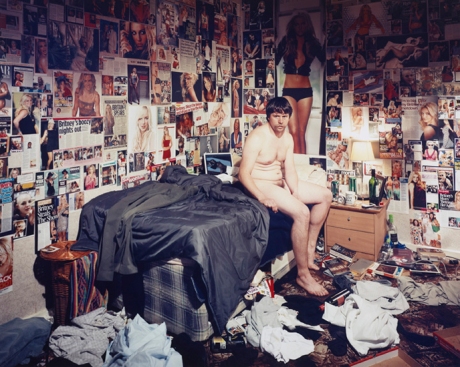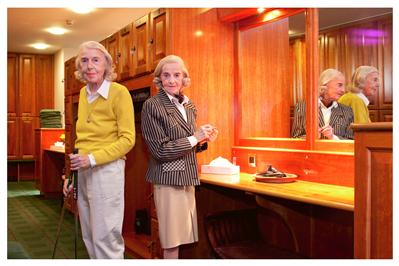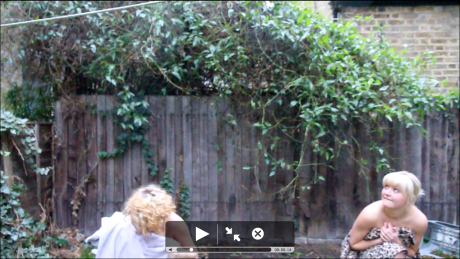“Dog is a man’s best friend, but also a silent observer of one’s life”
Tate Britain – Gabrielle Orozco Exhibition
Dial Tone 1992
Orozco sliced the pages of the New York phone book into columns of digits and pasted these now-anonymous telephone numbers next to one another on a ten-metre roll of Japanese paper. The source of these numbers remains recognisable because of the distinctive, everyday format of the telephone directory. As with his car sculpture, La DS, the object’s identity remains even while the artist’s radical edits remove its utility. ‘In a way this work is measuring a city’, Orozco has said.
National Portrait Gallery
Steven Barritt – Solitude of Pygmalion
His Webisite, including other photo’s in the series: http://www.stevenbarritt.com/mythographies
Anita Corbin – Golfing Sisters in the Ladies Locker Room
Sharif Waked – Chic Point
Merry Alpern – ‘Dirty Windows’ and ‘Shopping’
In 1995, with the unexpected help of an NEA rejection, Merry Alpern became notorious for her photo series “Dirty Windows.” Even if they couldn’t resist looking, viewers were made uneasy by these voyeuristic images, secretly taken through the bathroom window of a low-rent sex club near Wall Street. For the series, Alpern hid out in a building across an air shaft, capturing blow jobs, strip teases, coke-snorting, and a host of other activities with a telephoto lens. Now she’s come out in the open, sort of, to document another form of commerce: women rifling through clothing racks, trying on bathing suits, handing over the plastic – that is, shopping. But the brisk, businesslike missions of these women aren’t so far removed from the single-minded, sensual pursuits of the male figures in “Dirty Windows.” After all, if men purchase sex, at best, to relieve stress or to escape from ordinary life, it could be argued that many women shop for the same reasons.
With a tiny surveillance camera and a video camcorder hidden in her discreetly perforated purse, Alpern wandered through department stores, malls, and fitting rooms. Whereas each scene in the earlier series was framed by the same set of windows, the photos in “Shopping” (all 1999), painstakingly culled from hours of accumulated footage, are in a sense arbitrary and unmoored – even the camera was detached from the photographer’s eye.
In one photo, a pink buckled shoe hovers like some fabulous spacecraft over the rest of the fleet, black pumps and sling-backs lined up on clean white shelves; only the fingers glimpsed at the edge of the frame suggest that Alpern herself was holding the shoe. Other images are equally off-kilter, capitalizing on the trope of making the familiar strange through gross distortions or compositions that verge on the abstract. One picture is all swooping curves of beige-toned walls, accented with a few bright blobs of fluorescent lights, with only a man’s head barely visible above a heavy black diagonal line to indicate that this is a view of an escalator.
Why do we publish things?
We publish ideas, imagery, work and beliefs because we want to make these public. We want people to know.
But what about things we don’t want people to see or aren’t acceptable to be public?
Domestic Space, Thoughts, Our Bodies,communications and behaviors are all things we have personal control over. But what if this control was made public? What if we exposed your secrets, what you hide, What you know, Your personal details, What if your thoughts became broadcast nationwide?
Saying things we are not meant to say, doing things were not meant to do, making public what is not meant to be public. The politically incorrect, the shocking, the intrusive and the controversial.



